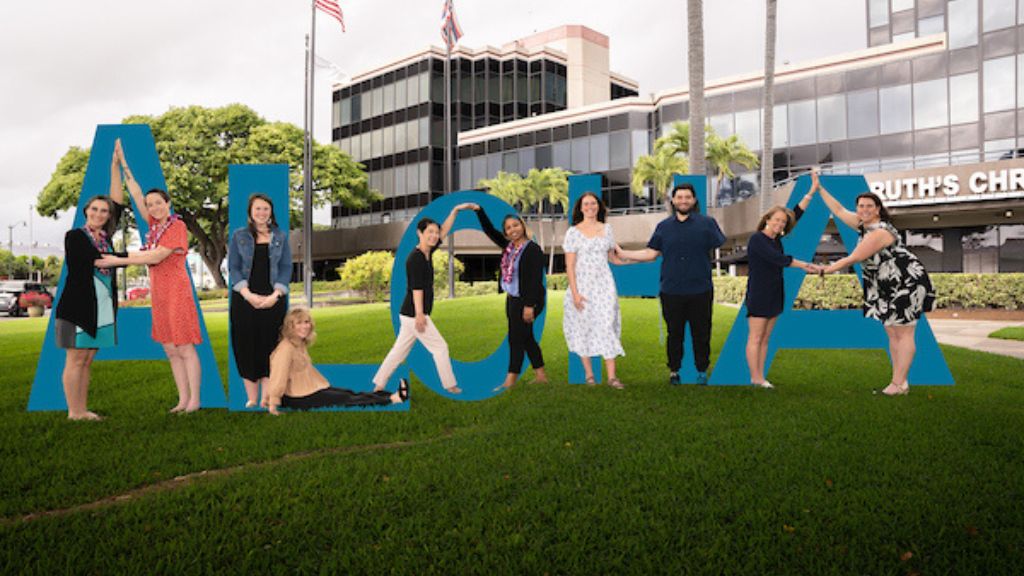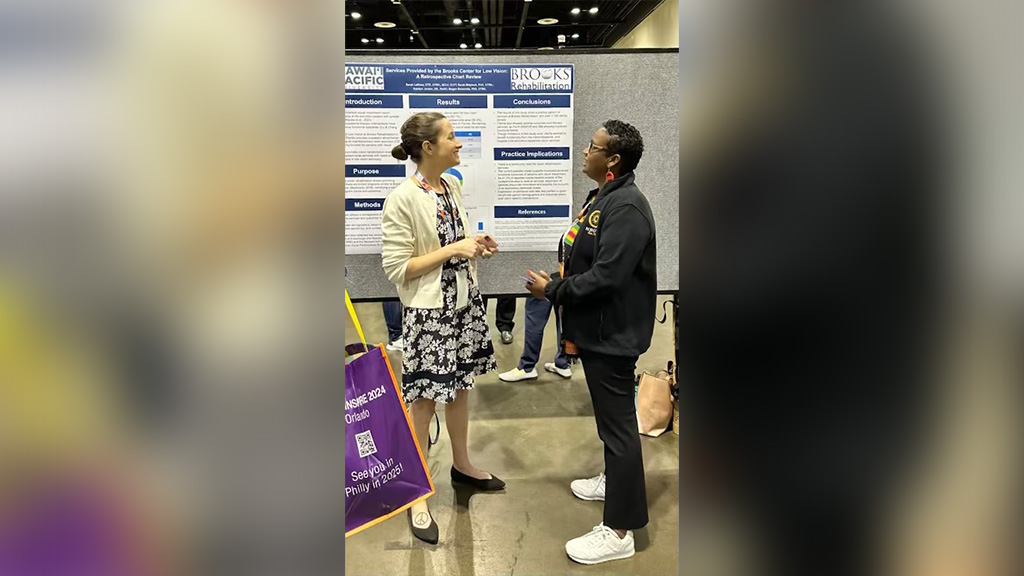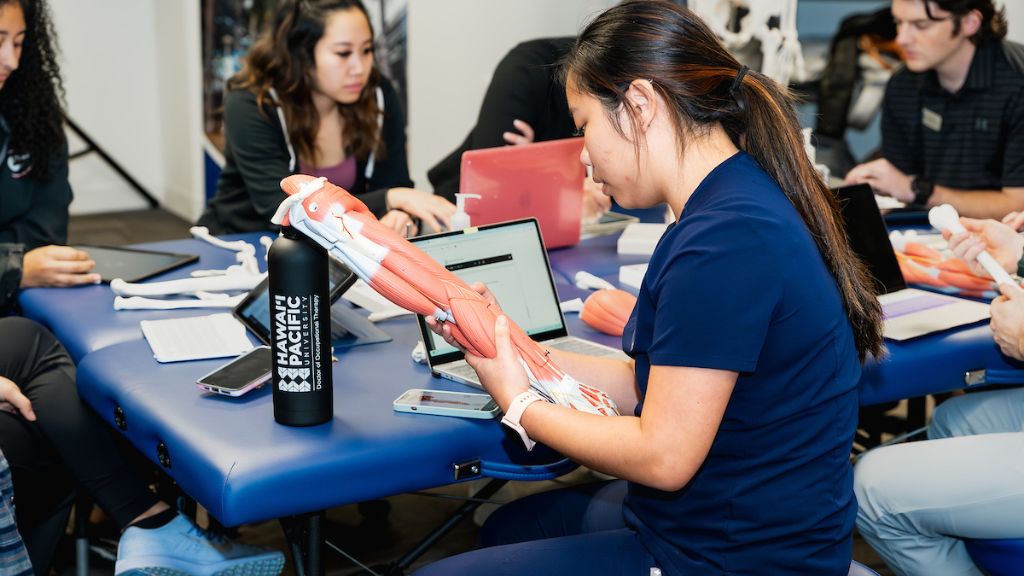Every April, Occupational Therapy Month is celebrated across the United States acknowledging the dedication, creativity, and passion that occupational therapists bring to the field and their patients each day.
For Sarah Blaylock, Ph.D., OTR/L, HPU Assistant Professor of Occupational Therapy, 2024’s Occupational Therapy Month is proving to be a little sweeter. Through her prior work as a professor of Occupational Therapy at both Nova Southeastern and Jacksonville Universities in Florida, Blaylock has left an indelible mark on the next generation of occupational therapists, and her clinical and research experience has impacted the field. But Blaylock is excited about educating a new population of occupational therapists as part of HPU’s pioneering hybrid Doctorate program at the University’s Honolulu campus.
“I love hybrid learning and virtual teaching,” she said. “When I was doing my Ph.D., I had two very young children and if I wasn’t allowed to take some hybrid courses during that time, I don’t think I would have made it. I fell in love with that medium of learning, to be able to reach students who we wouldn’t be able to reach otherwise.”
A Journey Born from Personal Experience
Blaylock’s venture into occupational therapy was not merely a choice but a calling, rooted in her own experiences with joint issues and surgeries during her youth. This exposure to the rehabilitation world unveiled the distinctive appeal of occupational therapy–a field dedicated to enhancing function and quality of life.
“It was so unique to see that there was a field that addressed function. I was really attracted to that mindset,” she said. Her passion was fueled by the diversity within the field, offering opportunities to impact lives across various settings, from pediatric care to working with older adults.
After completing her education at the University of Alabama at Birmingham and honing her craft in skilled nursing, Blaylock uncovered an interest in low vision rehabilitation. This niche, yet critical area focuses on optimizing function for individuals with visual impairments through innovative interventions and environmental modifications.
“Occupational therapy begins with the same process every time by doing an evaluation and determining where there is a functional breakdown,” she explained. “But with low vision clients and patients, there are a lot more environmental modifications that I will do as opposed to someone who has a physical diagnosis like a hip fracture and needs to learn how to dress themselves. The people I work with in a clinical setting have difficulty seeing their environment so I’m making modifications such as adding more light or implementing different light or installing higher contrast buttons on appliances in order to help them view their environment in the best way possible.”
Her pursuit of expertise in this area led her back to academia, where she embraced the roles of educator and researcher. At HPU, she is not just an instructor; she is a mentor, guiding students through the complexities of the field with a blend of rigor and compassion.
Her teaching philosophy is grounded in making complex concepts accessible and relatable, whether it’s demystifying anatomy, “which is a very scary subject to a lot of students,” or translating research into practice. Through her use of case studies and simulation, she challenges students to step into the shoes of their future clients, fostering empathy and critical thinking skills that are paramount in occupational therapy.
“I try to get my students into the mindset of living with some of these conditions. We have goggles in the lab that simulate vision impairment so I will have them put those on and then ask them to complete tasks like preparing a meal or testing their blood glucose – it’s scary to prick your finger when you can’t see the needle,” she said.
Revolutionizing Patient Care through Low Vision Research
Blaylock’s research endeavors are a testament to her commitment to advancing the field of occupational therapy. Collaborating with a team at Brooks Rehabilitation Center at Jacksonville University, she has been involved in the assessment of an interprofessional treatment system that seamlessly integrates the expertise of optometrists and occupational therapists.
“Brooks Rehabilitation was finding that people were slipping through the cracks during the intake process for conditions like, for example, a traumatic brain injury, which could impact someone’s vision but the evaluation system in place didn’t account for that,” she said. “They’ve set up a process where newly hired professionals at the hospital undergo training on how to screen patients for vision abnormalities and determine their vision status.”
This innovative approach not only improves functional outcomes for patients with low vision but also serves as a model for other healthcare facilities seeking to enhance their services.
“I am on the team looking at outcomes, which in three years, has shown to be very promising. We’ve reached about 1,200 individuals for services, many of them traveling from far away and they come here because of the unique system they’ve built,” she said.
Blaylock’s research also includes the exploration into visual acuity testing for individuals with cognitive impairments and her interest in the intersection of vision loss and sleep quality are paving the way for holistic approaches to patient care. Her efforts to disseminate these findings through national conferences and publications underscore her role as a thought leader in the occupational therapy community.
Inspiring the Next Generation of Occupational Therapists
For those drawn to the dynamic and creative world of occupational therapy, Blaylock offers words of wisdom: “Reach out for help,” she said. “Occupational therapists are some of the most welcoming, team-oriented people that you’re going to find. We want people to reach out to us and ask questions and make connections.”
She also emphasized the importance of mentorship, networking, and collaboration, and encouraged students and new professionals to seek guidance and engage with the broader community. Her message is clear–the path to innovation and impact in occupational therapy is through shared knowledge and collective endeavor.
But despite the strides made in the field, Blaylock also acknowledges that there are challenges that lie ahead for occupational therapists, including the ongoing need for greater public awareness of the work and research. Yet, her optimism is palpable.
“I think what is truly helping the profession as a whole are these wonderful educational programs like HPU’s that produce graduates who then go out into the world to explain who we are and what we’re doing,” she said.
Dr. Sarah Blaylock’s journey is more than a personal success story; it sheds light on the future potential of the field of occupational therapy. Through her unwavering dedication to her students, her innovative research, and her advocacy for the profession, she embodies the essence of occupational therapy–a field driven by the desire to improve lives.





